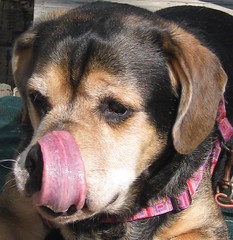
At Montrouge – Henri De Toulouse-Lautrec
I wrote about my first impressions of, At Montrouge: Rosa La Rouge, by Henri De Toulouse-Lautrec in an earlier post, “Rosa La Rouge,” was her name,” after buying the small framed print at a thrift shop.
I’ve learned that the model, Rosa, is a bit of a mystery.

Français : Carmen Gaudin – Boulevard extérieur
The sketch (on the right), from Wiki Commons sure looks like At Montrouge, however the model’s name is documented there as, Carmen Gaudin.
Below are the words to a song that I found online at http://www.Christies.com.
“It’s Rosa I don’t know she comes from
She has red hair, a dog’s head
When she passes they say, here comes ‘Red’
At Montrouge.When she gets a ‘John’ in the corner
Me, I’m right there not far at all
And the next day the cop finds ‘red’ all right,
At Montrouge.”
Not such a pleasing song for such a lovely woman, even if she was a prostitute.
I learned a bit more about Rosa from a Princeton blog (below).
“Redheads occupy a significant place in the work of Toulouse-Lautrec. As he declared to his atelier friends in 1884, his preference came from a characteristic odor of the redheads that he found arousing —
–Since the reason he liked to paint her (Rosa) was that he identified himself with her, and more specifically with her fake red hair, painting her as an ordinary brown-haired woman would have had the same connotations as considering himself an ordinary aristocrat, a condition from which he was getting farther and farther away.” (Source: The Calling of the Rose — See below for links)
An interesting and informed comment came in for this post from a friend and fellow blogger, Leslie Sigal Javorek, owner of IconDoIt. Leslie is also the artist who designed the awesome digital art in this post titled, Too Loose to Trek.
From Leslie:
“As to Rosa* she was indeed a prostitute but, unlike most of society (then as now), Lautrec neither felt nor exhibited disdain for these women, rather he believed them to be far more “real” and honest than the upper-class females that he had grown up with. In Lautrec’s voluminous body of work, including paintings and drawings, his models were almost always invariably prostitutes. While many have taken this as a sign of degeneracy, it was simply a fact of life in late-nineteenth century France and also the only source of female models willing to bare more than their face or occasionally their hands. Importantly, Lautrec never portrayed his models in a demeaning way. He was simply a “reporter”, an observer who tried to accurately capture the spirit of his models and surroundings without any moral judgment. If anything, Lautrec’s work accurately reflect his own gregarious, open-minded personality than believed in revering beauty and humanity over dogma.”
“* As to the song you refer to (above), I could find no confirmation whether or not this referred to Carmen specifically or whether it had any connection to Lautrec’s paintings and sketches of Carmen. I suspect that if that song had any connection to a Lautrec model, it would more likely have been Jane Avril, who was not only a red-head but was a popular singer & dancer at the Moulin Rouge at the time.”
Thank you Leslie!
“Too Loose to Trek” by Leslie Sigal Javorek
Henri De Toulouse-Lautrec was an interesting character. His life and work, and also the lives of his models and friends, led me on an interesting exploration with rich little surprises along the way, such as who is blamed for his early death.
Alas.
Her name was Rosa La Rouge!
~~~~~~~~~~~~~~~~~~
Thank you for visiting my blog.
All content in this blog, including text, images and external links is subject to a Creative Commons Attribution-Noncommercial-Share Alike 3.0 United States License.
Please see resources below for specific copyrights to images and/or text.
Resources:
sketch, commons.wikimedia.org
Too Loose to Trek, by Leslie Sigal Javorek, IconDoIt, the blog.
The Calling of the Rose, blogs.princeton.edu
song via http://www.Christie’s.com




























Recent Comments